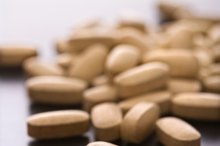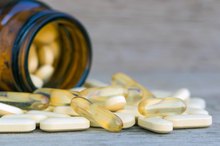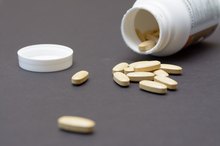What does fact checked mean?
At Healthfully, we strive to deliver objective content that is accurate and up-to-date. Our team periodically reviews articles in order to ensure content quality. The sources cited below consist of evidence from peer-reviewed journals, prominent medical organizations, academic associations, and government data.
- 2008 Journal of Rheumatology Study
- 2008 Journal of Rheumatology Study
- Mayo Clinic: Vitamin C and Gout
The information contained on this site is for informational purposes only, and should not be used as a substitute for the advice of a professional health care provider. Please check with the appropriate physician regarding health questions and concerns. Although we strive to deliver accurate and up-to-date information, no guarantee to that effect is made.
How to Reduce Uric Acid With Vitamins
Excessive uric acid in a person's body can lead to uric acid crystals forming in the joints and in tissue surrounding the joints 3. This condition is known as gout, a type of arthritis involving sudden attacks of severe joint pain and inflammation. Gout usually develops after years of high uric acid production associated with diet, and some people are more susceptible than others to this condition 3. If you are overweight, losing weight can help reduce uric acid 3. Avoiding foods high in purines, such as many types of meat and fish, can also decrease uric acid 3. Certain vitamins also can affect uric acid levels 3.
If you are experiencing serious medical symptoms, seek emergency treatment immediately.
Take vitamin C supplements. Research has shown that vitamin C is associated with reduced uric acid levels, such as a study published in the September 2008 issue of the Journal of Rheumatology 13. This study found that men taking up to 500 mg of vitamin C daily had lower serum uric acid concentrations than men who did not 3. Larger dosages did not result in more significant changes.
Does Vitamin B12 Make You Lose Weight?
Learn More
Ask your health care practitioner about the appropriate dosage of vitamin C supplements for you. The Mayo Clinic explains that very high doses of this vitamin can increase uric acid levels 23. High doses of vitamin C also can cause digestive upset and diarrhea. The Linus Pauling Institute at Oregon State University lists the maximum tolerable amount of vitamin C for adults as 2000 mg daily.
Eat more fruits and vegetables, as these contain vitamin C. Oranges, grapefruit, strawberries and juices from these fruits are especially beneficial. Cherries also are linked to lower levels of uric acid, according to the Mayo Clinic, and their website recommends adding other dark fruits for a uric-acid-reducing diet, including purple grapes, blackberries, blueberries and raspberries 23.
Vitamins for the Menstrual Cycle
Learn More
Avoid taking large amounts of vitamin B3 (niacin) supplements, since doses of 300 mg and higher have been linked to increased uric acid levels 3. The recommended daily allowance, commonly included in multivitamins, is 100 mg.
Avoid multivitamins that include high doses of zinc, which have been associated with increases in uric acid levels, as shown in a study published in the November 1986 issue of the American Journal of Medical Science 13. Recommended daily allowance of zinc is 11 mg for men and 8 mg for women.
Related Articles
References
- 2008 Journal of Rheumatology Study
- Mayo Clinic: Vitamin C and Gout
- Niacin and Uric Acid
- Benn CL, Dua P, Gurrell R, et al. Physiology of hyperuricemia and urate-lowering treatments. Front Med (Lausanne). 2018;5:160. doi:10.3389/fmed.2018.00160
- George C, Minter DA. Hyperuricemia. [Updated 2019 Jun 4]. In: StatPearls [Internet]. Treasure Island (FL): StatPearls Publishing; 2019 Jan-.
- Ramirez-Sandoval JC, Madero M. Treatment of hyperuricemia in chronic kidney disease. Contrib Nephrol. 2018;192:135-146. doi: 10.1159/000484288
- Wilson FP, Berns JS. Tumor lysis syndrome: new challenges and recent advances. Adv Chronic Kidney Dis. 2014;21(1):18–26. doi:10.1053/j.ackd.2013.07.001
- American Association for Clinical Chemistry. Uric acid. Reviewed May 17, 2017.
- Khanna D, Fitzgerald JD, Khanna PP, et al. 2012 American College of Rheumatology guidelines for management of gout. Part 1: systematic nonpharmacologic and pharmacologic therapeutic approaches to hyperuricemia. Arthritis Care Res (Hoboken). 2012;64:1431–46. doi: 10.1002/acr.21772
- Coburn BW, Bendlin KA, Sayles H, et al. Target serum urate: Do gout patients know their goal? Arthritis Care Res (Hoboken). 2016;68(7):1028-35. doi:10.1002/acr.22785
- Wiederkehr MR, Moe OW. Uric acid nephrolithiasis: a systemic metabolic disorder. Clin Rev Bone Miner Metab. 2011;9(3-4):207–217. doi:10.1007/s12018-011-9106-6
Writer Bio
Shelley Moore is a journalist and award-winning short-story writer. She specializes in writing about personal development, health, careers and personal finance. Moore has been published in "Family Circle" magazine and the "Milwaukee Sentinel" newspaper, along with numerous other national and regional magazines, daily and weekly newspapers and corporate publications. She has a Bachelor of Science in psychology.









